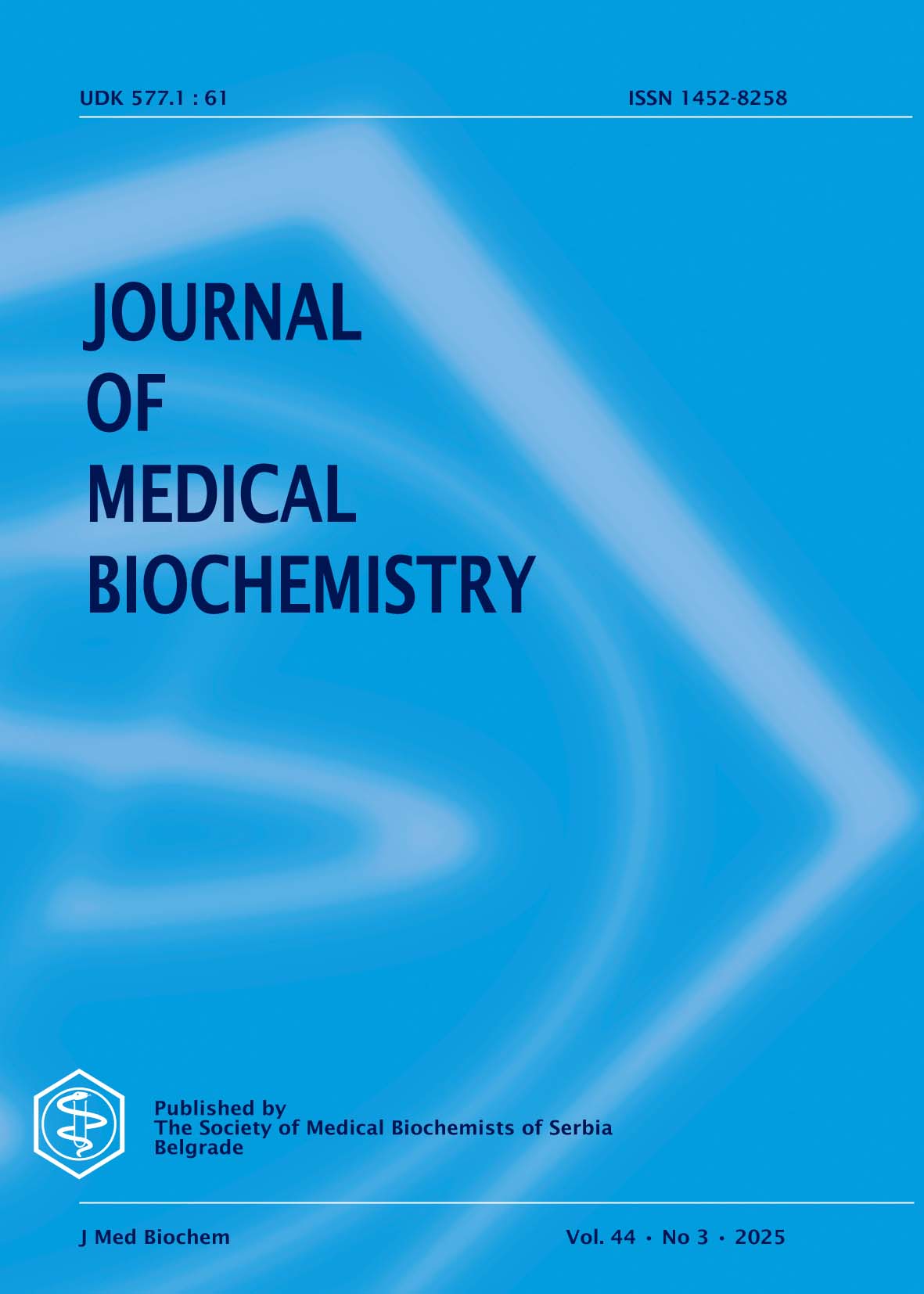Diagnostic value of HMGB-1 and Acetylcholinesterase in Assessing the Prognosis of Patients with Acute Pancreatitis
Diagnostic value of HMGB-1 and Acetylcholinesterase
Abstract
Aim: Acute pancreatitis (AP) is a disorder of tissue digestion caused by abnormal activation of pancreatic enzymes, which may lead to multi-organ failure and ultimately death as the disease progresses. How to quickly and accurately evaluate the progression of AP has always been a hotspot and difficulty in clinical research.
Methods: Sixty-four AP patients admitted to our hospital between August 2022 and June 2023 and 60 healthy people during the same period were selected for retrospective analysis, with AP patients as the observation group and healthy people as the control group. HMGB-1 and AChE levels were detected in both groups, and the diagnostic value of HMGB-1 and AChE for AP was analyzed using the receiver operating characteristic (ROC) curve. Subsequently, the differences in the expression of HMGB-1 and AChE in AP patients with different severities were further observed. In addition, we detected albumin (ALB), transferrin (TRF), and total protein (TP) in the observation group and analyzed their correlation with HMGB-1 and AChE. Finally, a 6-month prognostic follow-up was performed to analyze the predictive value of HMGB-1 and AChE for poor prognosis in AP using ROC curves.
Results: Compared with the control group, HMGB-1 was higher in the observation group, which was positively correlated with the severity of AP (P<0.05); while AChE was lower, which was negatively correlated with the severity of AP (P<0.05). HMGB-1+AChE had a sensitivity of 48.44% and a specificity of 88.33% for the diagnosis of AP (P<0.05, cut-off>0.639). In addition, HMGB-1 and nutrient protein were positively correlated and AChE and nutrient protein were negatively correlated in the observation group (P<0.05). Through the prognostic follow-up, it was seen that the diagnostic sensitivity of HMGB-1+AChE for poor prognosis of AP was 95.65% and the specificity was 65.85% (P<0.05).
Conclusion: HMGB-1 was elevated in AP,and AChE was decreased in AP, both of which have excellent diagnostic effects on the occurrence and poor prognosis of AP.
References
2. Mederos MA, Reber HA, Girgis MD. Acute Pancreatitis: A Review. JAMA. 2021;325(4):382-90.
3. Valverde-Lopez F, Martinez-Cara JG, Redondo-Cerezo E. Acute pancreatitis. Med Clin (Barc). 2022;158(11):556-63.
4. Yang AL, McNabb-Baltar J. Hypertriglyceridemia and acute pancreatitis. Pancreatology. 2020;20(5):795-800.
5. Casciaro M, Di Salvo E, Gangemi S. HMGB-1 in Psoriasis. Biomolecules. 2021;12(1).
6. Nogueira-Machado JA, de Oliveira Volpe CM. HMGB-1 as a target for inflammation controlling. Recent Pat Endocr Metab Immune Drug Discov. 2012;6(3):201-9.
7. Jo IJ, Bae GS, Park KC, Choi SB, Jung WS, Jung SY, et al. Scolopendra subspinipes mutilans protected the cerulein-induced acute pancreatitis by inhibiting high-mobility group box protein-1. World J Gastroenterol. 2013;19(10):1551-62.
8. Richbart SD, Merritt JC, Nolan NA, Dasgupta P. Acetylcholinesterase and human cancers. Adv Cancer Res. 2021;152:1-66.
9. Rajagopalan V, Venkataraman S, Rajendran DS, Vinoth Kumar V, Kumar VV, Rangasamy G. Acetylcholinesterase biosensors for electrochemical detection of neurotoxic pesticides and acetylcholine neurotransmitter: A literature review. Environ Res. 2023;227:115724.
10. Eckroat TJ, Manross DL, Cowan SC. Merged Tacrine-Based, Multitarget-Directed Acetylcholinesterase Inhibitors 2015-Present: Synthesis and Biological Activity. Int J Mol Sci. 2020;21(17).
11. Bestall SM, Hulse RP, Blackley Z, Swift M, Ved N, Paton K, et al. Sensory neuronal sensitisation occurs through HMGB-1-RAGE and TRPV1 in high-glucose conditions. J Cell Sci. 2018;131(14).
12. Szatmary P, Grammatikopoulos T, Cai W, Huang W, Mukherjee R, Halloran C, et al. Acute Pancreatitis: Diagnosis and Treatment. Drugs. 2022;82(12):1251-76.
13. Alberti P, Pando E, Mata R, Vidal L, Roson N, Mast R, et al. Evaluation of the modified computed tomography severity index (MCTSI) and computed tomography severity index (CTSI) in predicting severity and clinical outcomes in acute pancreatitis. J Dig Dis. 2021;22(1):41-8.
14. Lee PJ, Papachristou GI. New insights into acute pancreatitis. Nat Rev Gastroenterol Hepatol. 2019;16(8):479-96.
15. Garg R, Rustagi T. Management of Hypertriglyceridemia Induced Acute Pancreatitis. Biomed Res Int. 2018;2018:4721357.
16. Zhang X, Xie H, Liu Z, Zhang J, Deng L, Wu Q, et al. HMGB 1 acetylation mediates trichloroethylene-induced immune kidney injury by facilitating endothelial cell-podocyte communication. Ecotoxicol Environ Saf. 2023;259:115042.
17. Yang J, Tang X, Wu Q, Ren P, Yan Y, Liu W, et al. Heparin Protects Severe Acute Pancreatitis by Inhibiting HMGB-1 Active Secretion from Macrophages. Polymers (Basel). 2022;14(12).
18. Pohanka M. Diagnoses of Pathological States Based on Acetylcholinesterase and Butyrylcholinesterase. Curr Med Chem. 2020;27(18):2994-3011.
19. Khuanjing T, Palee S, Chattipakorn SC, Chattipakorn N. The effects of acetylcholinesterase inhibitors on the heart in acute myocardial infarction and heart failure: From cells to patient reports. Acta Physiol (Oxf). 2020;228(2):e13396.
20. Garg PK, Singh VP. Organ Failure Due to Systemic Injury in Acute Pancreatitis. Gastroenterology. 2019;156(7):2008-23.
21. Gliem N, Ammer-Herrmenau C, Ellenrieder V, Neesse A. Management of Severe Acute Pancreatitis: An Update. Digestion. 2021;102(4):503-7.
22. Zerem E, Kurtcehajic A, Kunosic S, Zerem Malkocevic D, Zerem O. Current trends in acute pancreatitis: Diagnostic and therapeutic challenges. World J Gastroenterol. 2023;29(18):2747-63.
Copyright (c) 2024 yan li

This work is licensed under a Creative Commons Attribution 4.0 International License.
The published articles will be distributed under the Creative Commons Attribution 4.0 International License (CC BY). It is allowed to copy and redistribute the material in any medium or format, and remix, transform, and build upon it for any purpose, even commercially, as long as appropriate credit is given to the original author(s), a link to the license is provided and it is indicated if changes were made. Users are required to provide full bibliographic description of the original publication (authors, article title, journal title, volume, issue, pages), as well as its DOI code. In electronic publishing, users are also required to link the content with both the original article published in Journal of Medical Biochemistry and the licence used.
Authors are able to enter into separate, additional contractual arrangements for the non-exclusive distribution of the journal's published version of the work (e.g., post it to an institutional repository or publish it in a book), with an acknowledgement of its initial publication in this journal.

